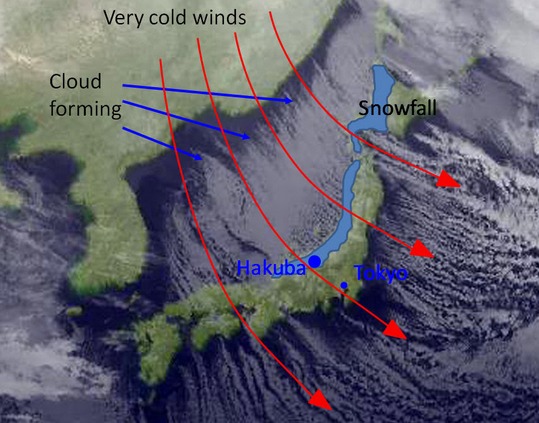
Originally written in 2013
Brought to you by HAKUBAVALLEY
Japan is the snowiest place on Earth. They get more snow than anywhere else in the world. There are places on Honshu Island (Tokyo’s island) that receive 1,200 to 1,500 inches of snow per year. Hakuba, Japan generally gets about 300 inches of snow in January alone. In 2015, Hakuba saw 600″ of snow in town in only 10 weeks. We were there for that (we spent 4 seasons in Hakuba, Japan 2012-2015). It was insane…
If you haven’t been to Japan yet, it’s time to go.

Why does Japan get so much snow?
A cold wind blows off Asia, picks up moisture off the Sea of Japan, and dumps that moisture as snow when it hits the mountainous isles of Japan. Like lake-effect snow, but sea-effect snow. It’s magic. You don’t need storms in Japan. You just need this wind to blow and voila! It snows.
Check out the image below:

When Is The Best Time to Ski/Ride Japan?
This snow carrying wind highlighted above blows consistently in January and February making these the best months to be in Japan. Before January can be dry and after February can be warm. March can be good for hiking and corn but generally isn’t great for powder.
If you have to pick only one month to go to Japan, we highly recommend January.
They don’t call it Japanuary for nothing…
January is the very most consistent snowfall month in Japan.

***
Related post:
The Top 6 Reasons To Go To Japan This Winter

The title should be “When is the best time to ski and ride HAKUBA” as this article is not about Japan but Hakuba. For example, n central Hokkaido. Centre Hokkaido gets less snow than the coastal regions but is colder and drier, great powder skiing starts in December and goes into March. Although not guaranteed, March, to about the 2oth, is more likely to be powder skiing than corn.
There is annual snow fall in excess of 30 meters in the main divide of the Southern Alps of New Zealand, that’s 100ft. So much snow falls that it is the only place in the world that glaciers descend into rain forest.
However this is incomparable to the likes of Japan as the areas in which this level of snowfall occurs is only accessible by helicopter or extreme hiking.
Just got back from Niseko and Asahidake, Hokkaido, Japan – reduced snow fall this year, not waist deep more knee deep. Went in 2010 – never seen motorways where there are walls of snow 10 feet tall ,so high you couldn’t see the other side nor the traffic. Pow was chest deep on slopes, had to keep my sticks at shoulder height and float down with pow spraying out like a wave. – japow, it’s legend.
Once again SnowBrains writers are willing to publish “brochure quotes” made up out of thin air without any due diligence.
http://www.snowjapan.com/japan-daily-snow-weather-reports has a daily log of snow reports going back to 2002-03. Here are the monthly and season averages since then for Niseko:
Nov. 45.9
Dec. 152.6
Jan. 170.4
Feb. 111.7
Mar. 72.1
Apr. 7.5
Total 560.2 inches
And for Hakuba:
Nov. 17.1
Dec. 113.5
Jan. 112.5
Feb. 87.3
Mar. 54.1
Apr. 6.7
Total 389.9
What’s most noteworthy is the midwinter concentration of snowfall, driven by maximum “lake effect” when the air from Siberia is coldest.
By comparison North American snowfall tends to be more evenly distributed December-March with significant snow in November and April in many places. Thus Alta, the gold standard of North American skiing, averages about 90 inches per month. So note that Hakuba gets more thatn that in January and Niseko nearly twice as much. 47% of Niseko January days see 6+ inches of snow vs. 22% at Alta. And by the way, “lake effect” snowfall is also low water content similar to Alta, even though Japan is an island and the altitude tops out at 4,400 feet in Niseko.
The truth about Japan’s snowfall is impressive enough from a skier’s perspective. Publishing wildly inflated numbers undermines that truth IMHO.
I agree, I love this site and i realize that you have some motivation to promote skiing, your site, and the industry, but you guys always inflate the numbers!!!
Bruce, 1 inch of snow contains about .1 inch of water (“precipitation”). Japan is a very wet place on earth but not the wettest one. They don’t say here, that Japan gets the most precipitations, just the biggest snow falls.
LOL 1500 inches – that’s absolute rubbish. Please do some research instead of blindly sharing info that. Just because one source said something doesn’t mean it’s true. The wettest locations on earth (non of which are in Japan) receive about 300-450 inches of annual precipitation, yet you’re saying this location receives 3-4 times that?!? Come on! It’s likely more in the 60-90 inch range – still very impressive!
Clearly, you’re never been to Japan…
http://staging.snowbrains.com/where-the-heck-is-this-photo-from-anyway-40-foot-tall-snowbanks/
Huh?
1500 inches? Or do you mean 1500 centimeters? BIG difference!!
http://hakubahouse.com/hakuba-info/resort-conditions/
Nope, we mean 1,500 inches. Northern Honshu. Crazy, right?
http://www.wunderground.com/blog/weatherhistorian/where-does-the-deepest-snow-on-earth-accumulate